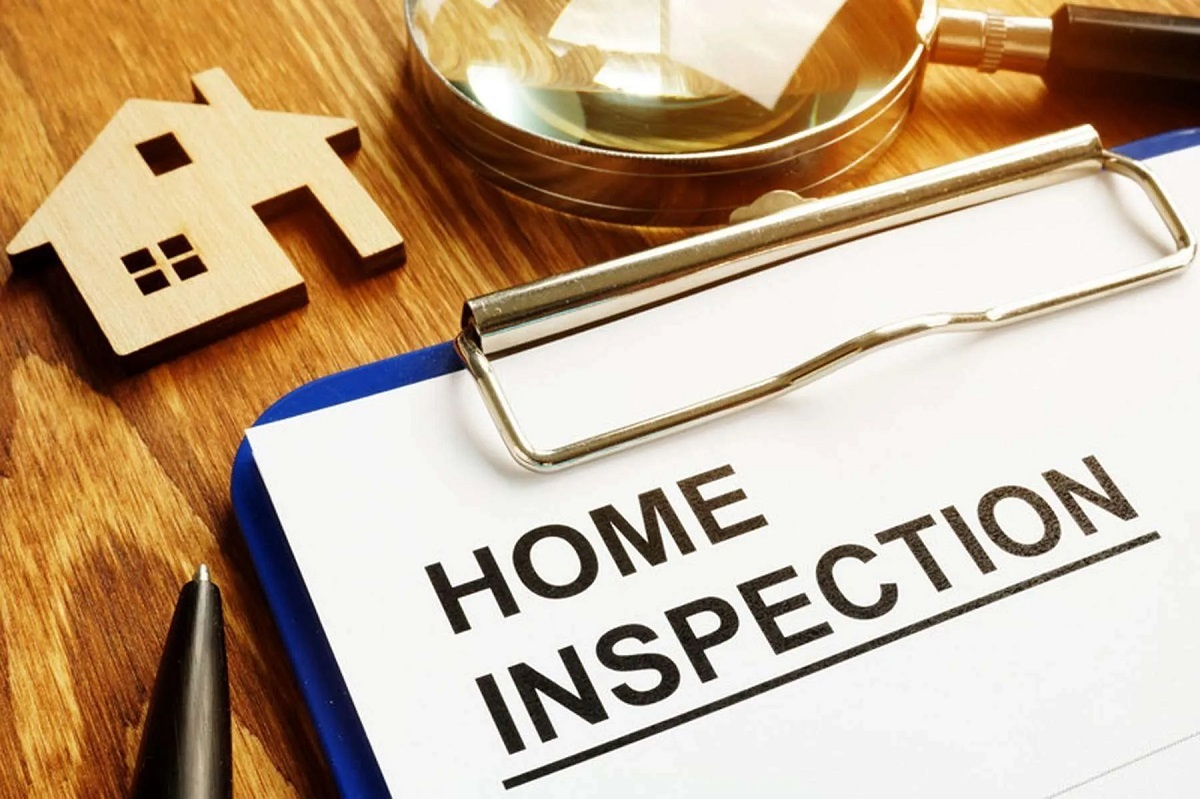Home>Home Maintenance>What Is A Buyer’s Inspection Advisory?


Home Maintenance
What Is A Buyer’s Inspection Advisory?
Modified: March 6, 2024
Learn about the importance of a buyer's inspection advisory for home maintenance and make an informed decision before making a purchase.
(Many of the links in this article redirect to a specific reviewed product. Your purchase of these products through affiliate links helps to generate commission for Storables.com, at no extra cost. Learn more)
Introduction
Welcome to the world of home maintenance! As a homeowner, it’s important to understand the various aspects of maintaining your property to ensure it remains in good condition. One crucial element of this is conducting regular inspections to identify any issues that may need attention.
When purchasing a home, one key step in the process is the buyer’s inspection. This is an essential assessment carried out by a professional inspector to evaluate the condition of the property. It provides valuable insights into the current state of the home, highlighting any potential concerns or required repairs.
While most buyers are familiar with the general concept of a home inspection, you may not be familiar with another critical aspect: the buyer’s inspection advisory. In this article, we’ll delve into what a buyer’s inspection advisory is, its purpose, and why it should matter to you as a homeowner.
So, let’s dive in and explore the world of buyer’s inspection advisories, and discover how they can benefit you in your quest to maintain and protect your home.
Key Takeaways:
- A buyer’s inspection advisory is a detailed report that helps homebuyers understand the condition of a property before purchasing. It highlights any issues and empowers buyers to make informed decisions.
- The advisory is a valuable negotiation tool, allowing buyers to request repairs or adjust the purchase price based on the findings. It provides peace of mind and helps protect the buyer’s investment.
Definition of a Buyer’s Inspection Advisory
A buyer’s inspection advisory is a document provided to homebuyers after a professional inspection has been conducted on a property. It serves as a comprehensive report that details the findings of the inspection, highlighting any issues or areas of concern that were discovered.
The advisory is typically prepared by the home inspector in a clear and concise manner, outlining the condition of various components of the home, such as the structural integrity, electrical systems, plumbing, HVAC, roof, and other important aspects. It provides an assessment of the overall state of the property, including both visible and non-visible defects.
This document is an essential aspect of the homebuying process, as it offers buyers valuable insights into the condition of the property they are considering purchasing. By reviewing the buyer’s inspection advisory, potential buyers can make informed decisions about the home and negotiate any necessary repairs or modifications with the seller.
It’s important to note that a buyer’s inspection advisory is not the same as a formal appraisal or a warranty on the property. While an appraisal determines the fair market value of the home, and a warranty provides protection against certain defects or issues, the inspection advisory focuses specifically on the condition of the property at the time of the inspection.
The advisory acts as a snapshot of the home’s condition and is meant to inform the buyer about any areas of concern. It is designed to provide an unbiased assessment, highlighting both minor and major issues that may impact the value and livability of the property.
Overall, a buyer’s inspection advisory serves as a crucial document that empowers homebuyers to make informed decisions and understand the potential risks and costs associated with the property they are considering purchasing.
Purpose of a Buyer’s Inspection Advisory
The primary purpose of a buyer’s inspection advisory is to provide homebuyers with critical information about the condition of a property. By detailing the findings of the inspection, the advisory helps buyers gain a comprehensive understanding of the home’s current state and any potential issues that may need to be addressed.
One key goal of the advisory is to uncover any hidden defects or problems that may not be immediately apparent during a typical walkthrough. While buyers may visually inspect a property themselves, a professional home inspector has the knowledge and expertise to identify underlying issues that may not be easily detectable to an untrained eye.
The advisory aims to ensure that homebuyers are well-informed and aware of any existing or potential problems before completing the purchase. Armed with this information, buyers can make educated decisions about proceeding with the transaction, renegotiating the terms, or requesting repairs from the seller.
Furthermore, the advisory serves as a valuable tool for negotiating with the seller. If significant issues or safety concerns are identified in the inspection, the buyer can use the advisory as leverage to request repairs or potentially negotiate a lower price to account for the cost of necessary repairs or upgrades.
In some cases, a buyer’s inspection advisory may also outline the expected lifespan of certain components and systems within the home. This information can help buyers anticipate future maintenance or replacement costs and plan accordingly, ensuring they have a clear understanding of the long-term investment they are making.
Moreover, the advisory provides buyers with peace of mind. By having a thorough assessment of the property, buyers can move forward with confidence, knowing they have made an informed decision based on objective information about the condition of the home they are purchasing.
Ultimately, the purpose of a buyer’s inspection advisory is to empower homebuyers by providing them with a comprehensive report on the condition of the property. This allows them to make informed decisions, negotiate effectively, and protect their investment in the long run.
When is a Buyer’s Inspection Advisory Provided?
A buyer’s inspection advisory is typically provided to homebuyers after a professional inspection has been conducted on a property. The timing of when it is provided may vary depending on the terms of the real estate transaction and any negotiated agreements between the buyer and seller.
In many cases, the buyer’s inspection advisory is provided during the due diligence period, which is a specific window of time negotiated between the buyer and seller. During this period, the buyer has the opportunity to conduct a thorough inspection of the property and review the findings before making a final decision on whether to proceed with the purchase.
Homebuyers often hire a qualified home inspector to perform a comprehensive assessment of the property. The inspector will thoroughly examine the home, testing various systems and components, and identifying any potential issues or defects.
Once the inspection is complete, the home inspector will compile their findings into a buyer’s inspection advisory. This report will typically be provided to the buyer within a specified timeframe, allowing them ample time to review the information and make an informed decision.
It is crucial for homebuyers to carefully review the buyer’s inspection advisory and understand its implications before moving forward. This is the time to assess the overall condition of the home, take note of any major issues or safety concerns, and consider the potential costs involved in addressing these issues.
Depending on the findings of the inspection, the buyer may choose to negotiate with the seller regarding necessary repairs or potential adjustments to the purchase price. The advisory serves as a valuable tool in these negotiations, providing supporting evidence and documentation for any requests the buyer may make.
In some cases, the buyer’s inspection advisory may also be shared with the seller, allowing them to gain insights into the condition of their property as well. This transparency can help facilitate open communication and a fair resolution to any concerns identified in the inspection.
Overall, a buyer’s inspection advisory is typically provided to homebuyers after a professional inspection has been conducted during the due diligence period. It serves as a crucial document for buyers to assess the condition of the property and make informed decisions about proceeding with the purchase.
What is Included in a Buyer’s Inspection Advisory?
A buyer’s inspection advisory is a comprehensive document that provides detailed information about the condition of a property. It includes a thorough assessment of various components and systems within the home, highlighting both visible and non-visible defects, potential safety issues, and general maintenance recommendations.
Here are some of the key aspects typically included in a buyer’s inspection advisory:
- Structural components: This section of the advisory focuses on the foundation, walls, floors, roof, and other structural elements of the home. It assesses the integrity of these components, identifying any signs of damage, decay, or structural issues.
- Exterior: The exterior section evaluates the condition of the siding, windows, doors, gutters, and other external features. It looks for signs of damage, water intrusion, rot, or other issues that may impact the overall condition and curb appeal of the property.
- Interior: This portion of the advisory covers the condition of the interior spaces, including walls, ceilings, floors, windows, doors, and any visible signs of damage or wear and tear.
- Electrical systems: The advisory assesses the electrical wiring, outlets, switches, and the main electrical panel. It flags any outdated or faulty wiring, safety concerns, or potential fire hazards.
- Plumbing: This section evaluates the plumbing system, including pipes, fixtures, faucets, toilets, and water heaters. It checks for leaks, water pressure issues, and potential plumbing-related problems.
- Heating, ventilation, and air conditioning (HVAC): The HVAC section examines the operation and condition of the heating and cooling systems. It includes an assessment of the furnace, air conditioner, ductwork, and ventilation to identify any issues or required maintenance.
- Roof and attic: This part of the advisory focuses on the condition of the roof, including its age, material, and any signs of damage or leaks. It also examines the attic space for proper insulation, ventilation, and potential issues such as pest infestation or structural damage.
- Additional areas: Depending on the property, the advisory may include a review of other areas such as the basement, crawl spaces, garage, or any other valuable features or components specific to the home.
Furthermore, the buyer’s inspection advisory may include photographs or diagrams to illustrate the identified issues and provide visual evidence. It may also offer recommendations for additional specialized inspections or professional evaluations if specific concerns are noted during the initial inspection.
It’s important to note that while a buyer’s inspection advisory is comprehensive, it may not cover every minor detail or cosmetic issue. The focus is primarily on significant defects, safety concerns, and potential long-term maintenance or repair needs.
By understanding what is included in a buyer’s inspection advisory, homebuyers can fully assess the condition of the property and make informed decisions about their purchase.
When buying a property, always request a Buyer’s Inspection Advisory. This document outlines the buyer’s rights and responsibilities during the inspection process, helping to ensure a thorough and fair assessment of the property’s condition.
Importance of a Buyer’s Inspection Advisory
A buyer’s inspection advisory plays a crucial role in the homebuying process, offering numerous benefits and ensuring informed decision-making. Understanding the importance of this document is essential for any buyer looking to make a confident and informed purchase. Here are some key reasons why a buyer’s inspection advisory is important:
- Identifies potential issues: One of the primary reasons for conducting a home inspection and reviewing the advisory is to identify any hidden or underlying issues within the property. The advisory will highlight any major defects, safety concerns, or structural issues that may require attention. This information allows the buyer to understand the current condition of the home and make informed decisions.
- Facilitates negotiation: Armed with the information provided in the advisory, buyers have the opportunity to negotiate with the seller. If significant issues or safety concerns are uncovered during the inspection, buyers can use the advisory to request repairs or adjust the purchase price to offset the cost of necessary repairs. The advisory serves as documentation and evidence to support negotiations and ensure a fair and equitable transaction.
- Plan for future maintenance: The buyer’s inspection advisory provides insight into the long-term maintenance needs and potential costs associated with the property. By understanding the expected lifespan of various components, such as the roof, HVAC system, or plumbing, buyers can plan and budget for future repairs or replacements. This proactive approach helps avoid unexpected costs down the line and ensures the home is well-maintained.
- Peace of mind: Buying a home is a significant investment, both financially and emotionally. A buyer’s inspection advisory offers buyers peace of mind by providing a thorough assessment of the property. By understanding the condition of the home and addressing any major concerns, buyers can proceed with confidence, knowing they have made an informed decision based on objective information.
- Ensures safety: The inspection and resulting advisory can uncover potential safety hazards within the property. Whether it’s faulty wiring, structural weaknesses, or other safety concerns, the advisory alerts buyers to any risks and allows them to take necessary actions to address these issues before moving in. Ensuring the safety of the property and its occupants is of utmost importance.
- Protection for investment: A buyer’s inspection advisory serves as a form of protection for the buyer’s investment. By understanding the condition of the property before purchasing, buyers can avoid unexpected expenses and budget accordingly for any necessary repairs or upgrades. The advisory helps buyers make an informed decision and minimizes the risk of encountering major issues post-purchase.
Overall, a buyer’s inspection advisory is an indispensable tool for homebuyers. It provides a comprehensive assessment of the property, helps identify potential issues, facilitates negotiations, and gives buyers the confidence and peace of mind when making one of the most significant investments of their lives.
Benefits of a Buyer’s Inspection Advisory
A buyer’s inspection advisory offers several valuable benefits to homebuyers. It provides crucial information and insights that can greatly impact the decision-making process. Let’s explore some of the key benefits:
- Knowledge of the property: Through the detailed assessment provided in the buyer’s inspection advisory, homebuyers gain a comprehensive understanding of the property’s condition. The advisory highlights any issues, defects, or potential maintenance requirements, empowering buyers to make informed decisions.
- Transparency: The advisory promotes transparency between the buyer and the seller. It ensures that both parties have a clear understanding of the property’s condition, reducing the chances of disputes or surprises after the purchase. This transparency helps foster a fair and amicable transaction.
- Negotiation tool: The information contained in the advisory can be used as a powerful negotiation tool. If significant issues are identified, buyers can leverage the advisory to request repairs, replacements, or monetary compensation from the seller. Having tangible evidence and professional insights strengthens the buyer’s position during negotiations.
- Financial savings: By uncovering potential issues, the advisory allows buyers to estimate the costs involved in addressing those concerns. This knowledge helps buyers make an informed decision about whether they are willing and financially capable of handling the identified repairs or maintenance tasks. It ensures buyers have a realistic understanding of the potential financial obligations associated with the property.
- Priority planning: The advisory helps buyers prioritize their needs and plan for future improvements. By understanding the condition of the property, buyers can focus on addressing immediate concerns and allocate resources for necessary repairs or upgrades over time. This proactive approach allows buyers to manage their budget and prioritize projects based on urgency and importance.
- Peace of mind: Knowledge is power, and the advisory provides buyers with peace of mind. By having a thorough understanding of the property’s condition, buyers can move forward with confidence, knowing they have made an informed choice. This peace of mind is invaluable, considering the significant investment and emotional attachment involved in purchasing a home.
- Building a professional network: During the inspection process, buyers have the opportunity to interact with and gain insights from the home inspector. This can lead to building a professional network of contacts who can provide guidance, recommendations, and future services. Establishing these connections can prove useful beyond the initial home purchase.
Ultimately, a buyer’s inspection advisory offers numerous benefits. It equips homebuyers with the necessary knowledge to make informed decisions, negotiate effectively, prioritize repair and maintenance tasks, and confidently move forward with their purchase. It is a vital tool in ensuring a smooth and successful homebuying process.
Limitations of a Buyer’s Inspection Advisory
While a buyer’s inspection advisory provides valuable information and insights, it is important to be aware of its limitations. Understanding these limitations helps buyers set realistic expectations and make informed decisions. Here are some key limitations to consider:
- Scope of the inspection: The advisory is based on a visual inspection conducted by a qualified professional during a specific timeframe. It does not involve destructive testing or invasive examinations of the property. Certain issues may only become apparent as time progresses or through specialized inspections that go beyond the scope of a standard home inspection.
- Limited timeframe: The inspection is typically conducted over a few hours, depending on the size and complexity of the property. This limited timeframe may not allow for a comprehensive assessment of every system, component, or potential issue. Some defects or concerns may go unnoticed during the inspection, especially if they are intermittent or require specific conditions to manifest.
- Non-visible defects: The inspector’s observations are primarily based on visible and accessible areas of the property. Non-visible defects hidden behind walls, ceilings, or floor coverings may not be identified during the inspection. It is important to understand that the report cannot guarantee the absence of any latent, concealed, or inaccessible defects.
- Subjectivity: While inspectors strive to provide objective assessments, there may still be an element of subjectivity in their observations. Different inspectors may have varying opinions on the severity or significance of certain issues. Buyers should review the advisory with their own preferences and priorities in mind.
- No predictions of future issues: The buyer’s inspection advisory provides a snapshot of the property’s condition at the time of inspection. It cannot predict or anticipate future issues that may arise. The condition of certain components, such as the roof or HVAC system, can change over time and are subject to external factors. Regular maintenance and ongoing monitoring are necessary to ensure the long-term health of the property.
- Exclusion of specialized inspections: The buyer’s inspection advisory typically focuses on the general condition of the property and its major systems. It may not cover specialized areas such as geological stability, environmental hazards, or specific structural evaluations. Additional inspections by qualified professionals may be necessary for a more thorough assessment in these areas.
It is important for homebuyers to understand that while a buyer’s inspection advisory provides valuable information, it has its limitations. It serves as a tool to gain insights into the property’s condition at a specific point in time. Buyers should carefully review the report, ask questions, and consider additional inspections or evaluations if specific concerns arise.
By keeping these limitations in mind, buyers can manage their expectations and make well-informed decisions based on the information provided in the advisory.
Understanding and Reviewing a Buyer’s Inspection Advisory
When you receive the buyer’s inspection advisory, it is essential to take the time to thoroughly review and understand its contents. Here are some key steps to help you navigate and make the most of the advisory:
- Read the report carefully: Begin by reading the entire buyer’s inspection advisory from start to finish. Take your time to understand each section and the details provided. Pay attention to any prioritized or significant issues that the inspector has highlighted.
- Identify major concerns: Look for any major concerns or safety hazards that have been identified in the advisory. These could include structural issues, electrical or plumbing problems, or significant repairs that may be necessary. Recognize which items are most critical and may require immediate attention.
- Understand the implications: Consider the potential impact of the identified issues. Assess whether they are deal-breakers or if they can be resolved through repairs or negotiations with the seller. Evaluate the significance of the repairs in terms of cost, time, and potential inconvenience.
- Seek clarification: If there are any aspects of the report that you do not understand or require further clarification, reach out to the home inspector. They can provide additional information and insights to help you better comprehend the findings. It is important to have a clear understanding of the issues identified.
- Consult with professionals: Depending on the complexity of the issues mentioned in the advisory, it may be beneficial to seek the opinion of specialized professionals. For example, if there are concerns regarding the electrical system, consider consulting an electrician for a more in-depth evaluation and further guidance.
- Consider the costs: Evaluate the potential costs associated with addressing the identified issues. Obtain estimates from contractors or professionals to determine the financial impact of necessary repairs or replacements. This will help you assess the feasibility and affordability of the property in the long term.
- Prioritize repairs: Based on the severity and urgency of the repairs or maintenance tasks mentioned in the advisory, prioritize your actions. Determine which issues need immediate attention and which can be addressed over time. Develop a plan for addressing the repairs within a reasonable timeframe.
- Negotiate with the seller: If there are significant concerns or safety hazards identified in the report, use the advisory as a negotiation tool. Discuss the findings with the seller and explore possible resolutions. You may request repairs or negotiate a lower purchase price to account for the necessary repairs or upgrades.
- Review with your real estate agent: Share the buyer’s inspection advisory with your real estate agent, as they can provide valuable guidance and assistance throughout the process. They can help you understand the implications of the report, advise on negotiation strategies, and ensure your best interests are represented.
A buyer’s inspection advisory is a valuable resource, offering crucial insights into the condition of the property you intend to purchase. By carefully reviewing and understanding the report, seeking clarification when necessary, and taking appropriate actions, you can make informed decisions and ensure the property meets your expectations and requirements.
Conclusion
A buyer’s inspection advisory is an essential tool for homebuyers, providing valuable insights into the condition of a property and guiding informed decision-making. This comprehensive document, prepared by a professional home inspector, outlines the findings of the inspection and highlights any issues or concerns that may impact the value and safety of the home.
Throughout the homebuying process, the buyer’s inspection advisory serves multiple purposes. It helps homebuyers identify potential problems, negotiate with the seller, plan for future maintenance, and gain peace of mind. By understanding the limitations of the advisory and taking the necessary steps to review and interpret its contents, buyers can navigate the complexities of the home inspection process with confidence.
Remember to carefully review the advisory, paying close attention to any major concerns or safety hazards. Seek clarification from the home inspector if needed, and consider consulting with specialized professionals for further evaluation. Use the information provided in the advisory to prioritize repairs and negotiate with the seller, if necessary.
While a buyer’s inspection advisory is a valuable resource, it is crucial to recognize that it provides a snapshot of the property’s condition at a specific point in time. Regular maintenance, ongoing monitoring, and additional inspections may be necessary to ensure the long-term health of the property.
Ultimately, a buyer’s inspection advisory empowers homebuyers to make informed decisions and protect their investment. By understanding the importance of this document, carefully reviewing its contents, and taking appropriate actions, you can confidently move forward with your home purchase, knowing that you have thoroughly evaluated the condition of the property.
Remember, a buyer’s inspection advisory is just one piece of the puzzle in the homebuying process. It is essential to work closely with your real estate agent, communicate openly with the seller, and consider all relevant factors before making a final decision. By doing so, you can ensure a smooth and successful homebuying experience.
Frequently Asked Questions about What Is A Buyer's Inspection Advisory?
Was this page helpful?
At Storables.com, we guarantee accurate and reliable information. Our content, validated by Expert Board Contributors, is crafted following stringent Editorial Policies. We're committed to providing you with well-researched, expert-backed insights for all your informational needs.














0 thoughts on “What Is A Buyer’s Inspection Advisory?”